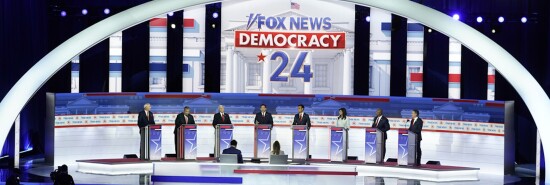
The GOP field is already shrinking
Byron York
THE GOP FIELD IS ALREADY SHRINKING. It has often been remarked that the first debate of the 2024 Republican presidential primary race, held Wednesday in Milwaukee, marks a new stage in the GOP campaign. One important part of that new stage is that the debate begins the process of cutting down the 13-candidate field. It’s already happening. Less than 48 hours after the debate, an argument could be made that the field is substantially smaller.
It’s a natural process. In the 2016 GOP race, which had a huge Republican field, five candidates withdrew before the end of 2015. The withdrawals, Rick Perry, Scott Walker, Bobby Jindal, Lindsey Graham, and George Pataki, started in September 2015. We’re approaching that point now.
Wednesday’s debate made some obvious cuts in the 2024 field. Candidates Larry Elder, Perry Johnson, Francis Suarez, and Will Hurd did not qualify for the debate even by minimal standards set by the Republican National Committee. So that’s a 13-candidate field going down to a nine-candidate field. It’s already done.
Subscribe today to the Washington Examiner magazine that will keep you up to date with what’s going on in Washington. SUBSCRIBE NOW: Just $1.00 an issue!
Then there are the final two candidates to qualify for the debate, Gov. Doug Burgum (R-ND) and former Arkansas Gov. Asa Hutchinson. Both used fundraising gimmicks to meet the RNC’s donor requirements, and both made little impact on the debate. There’s really no reason for them to continue participating in the debates. So that is a nine-candidate field going down to a seven-candidate field.
And then what? Perhaps the field will stay at seven candidates for a while. But it’s also possible a more radical cut is already happening and that the race is now effectively a five-candidate contest: former President Donald Trump, entrepreneur Vivek Ramaswamy, Gov. Ron DeSantis (R-FL), former South Carolina Gov. Nikki Haley, and former New Jersey Gov. Chris Christie.
There will be plenty of objections to that statement. The obvious question is, what about former Vice President Mike Pence and Sen. Tim Scott (R-SC)? Each man is an accomplished candidate, well qualified to be in the race. Both will continue to campaign and continue to qualify for debates. They will be voices in the conversation, but they will be lesser voices, in part because their views will be better represented by other candidates.
Look at it this way. There is no doubt Trump has remade the Republican Party. It is possible to place the candidates on what might be called the Trump Scale. The scale ranges from Trump himself on one end to the strongly anti-Trump Christie on the other. Everybody else is somewhere in between. I would put the Trump scale, in order of Trumpiness, like this: Trump — Ramaswamy — DeSantis — Scott — Haley — Pence — Christie.
Trump is the obvious leader, ahead of DeSantis by 41.1 points in the RealClearPolitics average of national polls. He’ll be in it all the way. Ramaswamy, ranking third nationally, has positioned himself as the Trumpiest of all candidates, only younger. (He is 38 years old.) Indeed, listening to Ramaswamy talk about Trump, it would be natural to wonder why one should not just vote for Trump himself.
DeSantis begins what might be called the Let’s Move On subgroup of the field. He’s Trumpy, with a governing view heavily influenced by the former president, but has also made clear that he believes the United States needs a new approach to presidential leadership. Haley is also in the Let’s Move On subgroup but has more grounding in the traditional Bush wing of the party. And then Christie, who is obviously in the Let’s Move On camp, represents the extreme of anti-Trump feeling inside the Republican Party.
The problem with Scott is that he overlaps with Haley but is not as able a campaigner and political performer. He’s also a senator, which, at least in the GOP, is a weaker platform on which to run than a governor with real executive experience. The problem with Pence is that he sits somewhere between Haley and Christie but is inching closer to Christie. There’s no room for two candidates on that end of the Trump Scale. Plus, given Pence’s history as Trump’s vice president, he has no comfortable place in a race against the president he served.
So five candidates — Trump, DeSantis, Ramaswamy, Haley, and Christie. That’s the group that will likely dominate the fall campaign until the field is winnowed even more.
For a deeper dive into many of the topics covered in the Daily Memo, please listen to my podcast, The Byron York Show — available on Radio America and the Ricochet Audio Network and everywhere else podcasts can be found.
